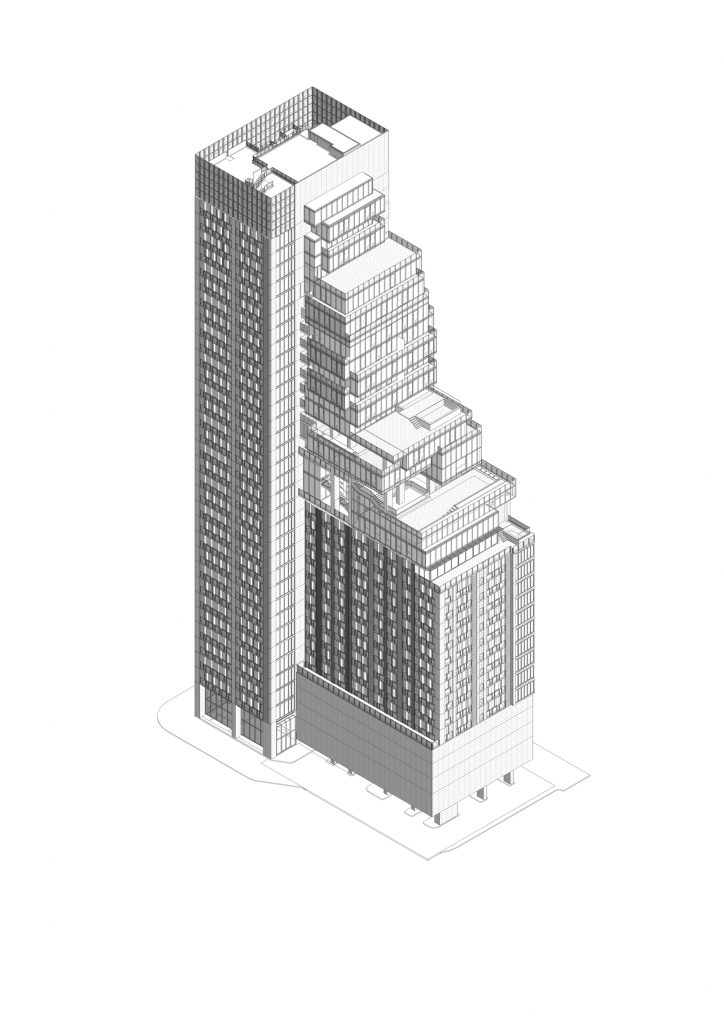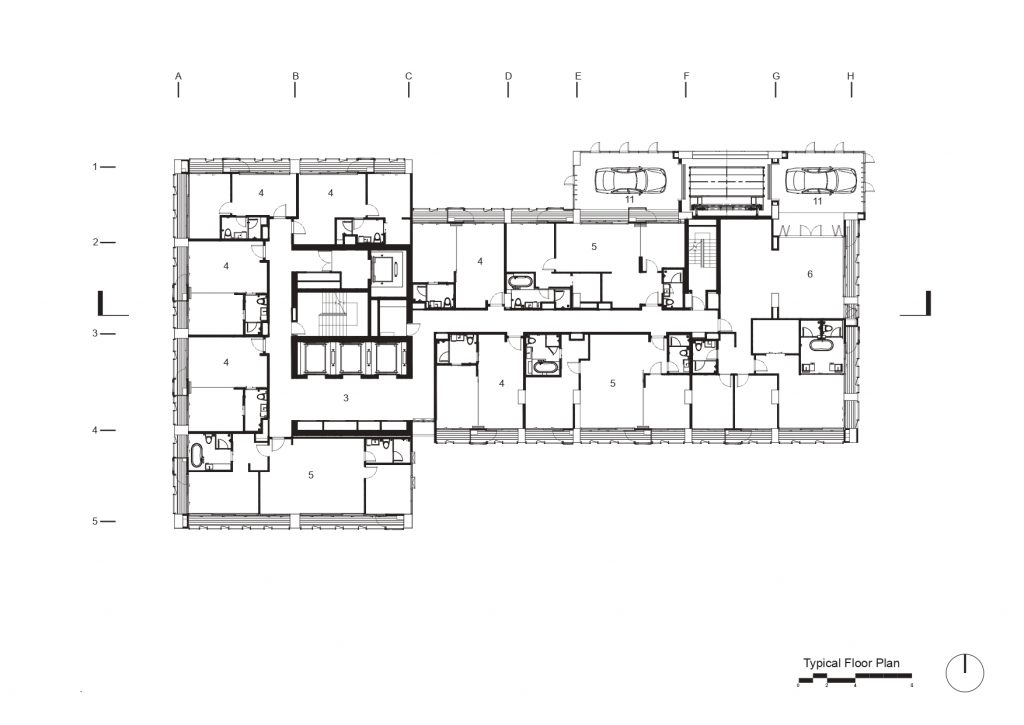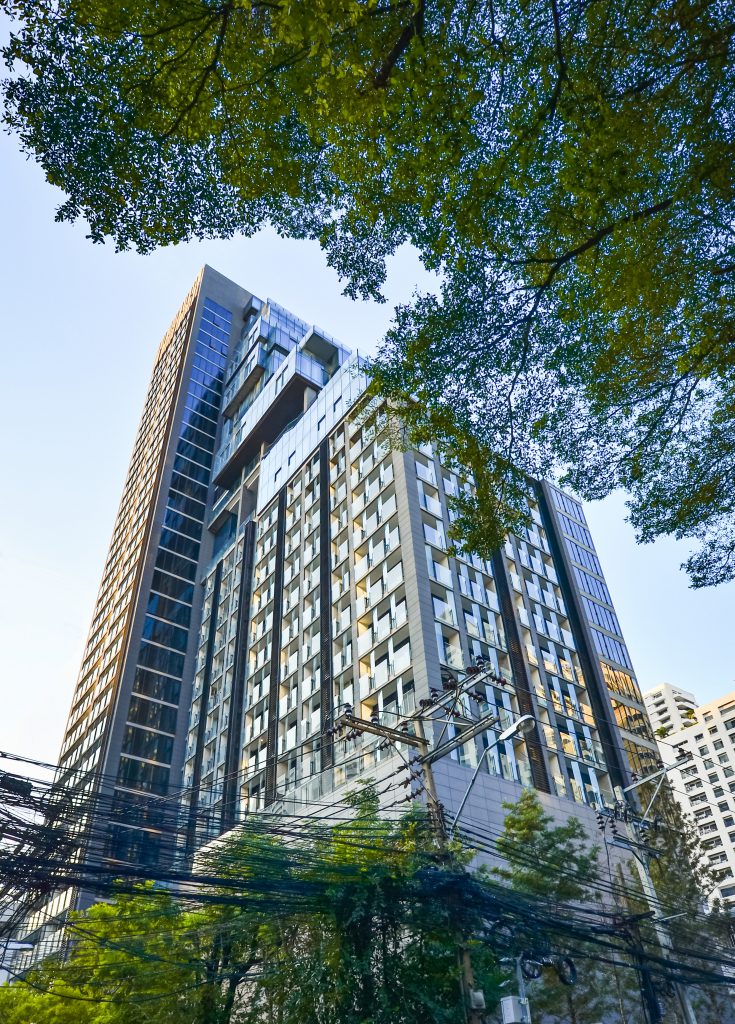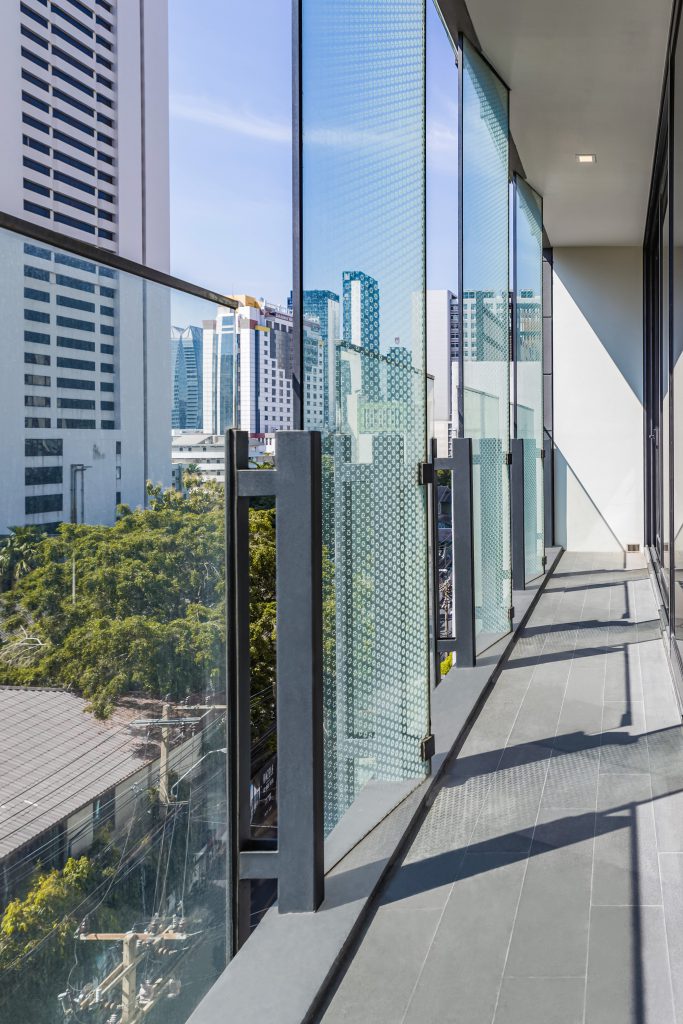Quintrix Architects has employed a variety of glass innovations to create new defini- tions for condominium architecture and new living experiences for dwellers in this luxury condominium design.
Text: Warut Duangkaewkart
Photo Courtesy of Quintrix Architects
Download the online journal Issue 03 Seeing Through Click here

รูปแบบของอาคารประเภทคอนโดมิเนียมพักอาศัยในเมืองนั้น มีการเปลี่ยนแปลงเกิดขึ้นอย่างต่อเนื่อง ซึ่งสามารถมองได้จากสภาพของเมือง การขยายพื้นที่อยู่อาศัยภายในเมือง โดยเฉพาะเมืองหลวงอย่างกรุงเทพมหานคร ซึ่งมีความหลากหลายของอาคารและความเปลี่ยนแปลงที่เห็นได้มากมายในช่วงเวลาไม่นานที่ผ่านมานี้ ประเด็นที่เห็นได้ชัดเจนอย่างหนึ่งก็คือรูปลักษณ์ของอาคารคอนโดมิเนียมพักอาศัยที่ เคยเป็นภาพของอาคารคอนกรีตทึบตัน มีหน้าต่างหรือช่องเปิดขนาดเล็ก กลายมาเป็นอาคารกระจกสูงโปร่ง ซึ่งเกิดขึ้นจากพฤติกรรมของผู้คนที่เปลี่ยนไป ผ่านการออกแบบที่ตอบสนองยุคสมัยที่ต่างกัน
Quintrix Architects เป็นสำนักงานสถาปนิกที่มีประสบการณ์ออกแบบงานสถาปัตยกรรมมามากมาย ด้วยความเชื่อในการออกแบบที่มีเป้าหมายแบบเรียบง่าย แต่ถูกแสดงออกมาผ่านวิธีการที่หลากหลาย ผ่านการทำงานเป็นทีมอย่างมีประสิทธิภาพ จากประสบการณ์ที่แตกต่างกัน ซึ่งเป็นสิ่งที่ Quintrix Architects เชื่อว่าจะทำให้งานออกแบบได้ผลลัพธ์ออกมาดีที่สุด พวกเขายังเชื่อด้วยว่าการออกแบบเพื่อสร้างเอกลักษณ์ของอาคาร ที่แม้จะเป็นอาคารประเภทเดียวกัน แต่สามารถใช้วิธีการที่ต่างกันในการสร้างสรรค์ จัดการปัญหา และ หาทางออกเพื่อให้ได้ผลลัพธ์ที่ดีที่สุดสำหรับแต่ละโครงการได้ และด้วยประสบการณ์ชีวิต และการทำงานที่ SOM ทั้งในอเมริกา และ อังกฤษ ทำให้นพพล พิสุทธอานนท์ สถาปนิกหนึ่งในผู้ก่อตั้ง Quintrix Architects มีมุมมองที่น่าสนใจในการออกแบบโครงการ Circle Sukhumvit 11 นี้

Circle Sukhumvit 11 ตั้งอยู่ในซอยสุขุมวิท 11 ใจกลางเมืองกรุงเทพฯ มีพื้นที่ใช้สอยรวมกว่า 28,000 ตารางเมตร จากความสูง 36 ชั้น ที่เมื่อมองจากภายนอกจะเห็นผนังกระจกที่เรียงตัวตั้งแต่พื้นล่างจนถึงส่วนบนสุดของอาคาร และ การจัดวางจังหวะของอาคารส่วนหน้าบริเวณด้านบน ที่ไล่ระดับเรียงตัวกันขึ้นไป โดยแบ่งสัดส่วนพื้นที่เป็นส่วนจอดรถบริเวณขั้นล่าง พื้นที่ห้องพักเรียงตัวขึ้นไปในแนวสูงทางด้านหลัง คั่นด้วยพื้นที่ส่วนกลางระหว่างกลาง ก่อนที่จะไล่ระดับไปจนถึงด้านบน เพื่อช่วยให้รูปทรงของอาคารนั้นเรียงตัวต่างออกไปเมื่อมองจากภายนอก แนวความคิดในการออกแบบเริ่มต้นจากการตั้งคำถามถึงการนำความเป็นอยู่รูปแบบบ้านพักอาศัย ให้มาอยู่ในรูปแบบของคอนโดมิเนียม สร้างความรู้สึกของผู้อยู่อาศัยให้ใกล้เคียงกับการอยู่บ้านมากที่สุด ซึ่งหมายถึงความสะดวกสบาย และความต่อเนื่องของพื้นที่ อย่างการขับรถกลับมาถึงบ้าน จอดรถ แล้วเดินเข้าไปยังตัวบ้านเพื่อพักผ่อนได้ทันที ไม่ใช่รูปแบบเดิมๆ ของคอนโดมิเนียมที่จะต้องเดินผ่านโถงล็อบบี้ แบบที่เราคุ้นชินกัน ซึ่งแนวความคิดนี้สะท้อนออกมาผ่านการออกแบบห้องชุดพิเศษที่สามารถนำรถขึ้นไปจอดยังห้องด้านบนได้ด้วยลิฟต์ส่วนตัว เพื่อลดความเชื่อมโยงแบบเดิมๆ และ ใกล้เคียงกับความรู้สึกของการกลับบ้านมากขึ้น และ เรื่องของที่จอดรถนี้เองก็ถูกประยุกต์ใช้กับการจัดการรถที่เหลือด้วยลิฟต์ทั้งหมด เพื่อลดปัญหาทั้งการจราจร การต้องขับรถวนหาที่จอด รวมไปถึงช่วยลดมลภาวะจากเครื่องยนต์ต่างๆ ที่จะเกิดขึ้นภายในอาคาร ความแตกต่าง หรือจุดเด่นของโครงการนี้ คือมุ่งเน้นในการนำนวัตกรรมต่างๆ เข้ามาใช้ในการออกแบบเพื่อสร้างประสบการณ์ชีวิตที่ดีขึ้น ทั้งในแง่ของเทคโนโลยีที่ช่วยอำนวยความสะดวก อย่างลิฟต์จอดรถ หรือที่จอดรถส่วนตัวที่อยู่ร่วมกับห้องพัก หรือในแง่มุมของการจัดการความร้อน และ การประหยัดพลังงานที่จะเกิดขึ้นในอาคาร ที่แสดงออกผ่านการใช้กระจกประหยัดพลังงาน และ การออกแบบ façade อีกทั้งยังใช้พลังงานหมุนเวียนจากโซล่าเซลล์เพื่อรองรับการใช้ไฟฟ้า ระบบปรับอากาศในพื้นที่ส่วนกลางของอาคาร และ การเลือกวัสดุที่ยั่งยืนนำมาใช้ในส่วนต่างๆ ของงานออกแบบ
façade ของอาคารจากภายนอก ถูกแบ่งออกอย่างชัดเจน ในส่วนของที่จอดรถ ที่พักอาศัย และ พื้นที่ส่วนกลาง พื้นที่จอดรถด้านล่างนั้นถูกปิดทึบจากภายนอก ก่อนที่จะมองเห็นผนังกระจกระเบียงของยูนิตต่างๆ ที่ถูกจัดวางเป็น แพทเทิร์นเรียงตัวกันขึ้นไป โดยส่วนนี้ผู้ออกแบบเลือกใช้กระจก Laminated เพื่อให้มีความแข็งแรง อีกทั้งยังเสริม Ceramic Frit Pattern มีลวดลายที่มาจาก Logo ของโครงการแทรกอยู่ตรงกลางระหว่างแผ่นกระจก เพื่อที่จะลดความร้อนเข้าสู่ตัวอาคาร พร้อมทั้งบิดแกนของแผงกันแดด ให้เอียง 15 องศา เพื่อสร้างกระสะท้อนจากพื้นผิว และลดการมองเห็นจากภายนอก ซึ่งเป็นส่วนสำคัญที่ถูกจัดวางเรียงตัวกันจนเกิดเป็น façade ผืนใหญ่ของอาคารหลังนี้

จุดเด่นอีกส่วนหนึ่งของโครงการนี้คือ ส่วนที่ถูกออกแบบให้เป็น Pixelated Zone ที่เริ่มต้นตั้งแต่บริเวณสระว่ายน้ำ ที่ถูกจัดวางให้อยู่ในโซนที่สูงปานกลาง เพื่อทำให้เห็นมุมมองไปยังทิวทัศน์ภายในเมือง ซึ่งองค์ประกอบต่างๆ เกิดจากความต้องการของผู้ออกแบบที่อยากให้ส่วน facilities นั้นเป็นพื้นที่ที่ไล่ระดับ และเชื่อมถึงกันได้ อีกทั้งยังตอบโจทย์ในการออกแบบตามกฏหมายก่อสร้างอีกด้วย ฟังก์ชั่นทั้งหมดในส่วนนี้ จากสระว่ายน้ำ ไปยังห้องสมุด และฟิตเนส สามารถเดินเชื่อมถึงกันได้จากพื้นที่ไล่ระดับภายนอก ส่วนพื้นที่ที่อยู่สูงขึ้นไป จะเป็นห้องแบบพิเศษอีกชุดหนึ่งที่ถูกออกแบบให้มีความแตกต่างกันในแต่ละชั้น ไล่ระดับไปจนถึงส่วนยอดของอาคาร อีกประเด็นที่สร้างความพิเศษให้กับ Pixelated Zone คือการออกแบบระบบ curtain wall เพื่อให้ได้ผืนกระจกที่กว้างที่สุดในการใช้งาน และเลือกใช้กระจกศูนย์อากาศ (IGU) ที่มี Soft Coat Low-E เพื่อลดความร้อน ทำให้พื้นผิวภายนอกของอาคารส่วนนี้ มีการสะท้อนแสงที่แตกต่างกันออกไป และ ทำให้สามารถเห็นมวลของอาคารที่ยุบ ยื่น ได้ชัดเจนมากยิ่งขึ้น จากพื้นที่ภายนอกเข้าสู่ภายใน สถาปนิกได้ออกแบบที่อยู่อาศัยโดยคำนึงถึงความรู้สึกของคน ที่พยายามทำให้พื้นที่นั้นเปิดโล่ง มองเห็นภายนอกได้กว้างที่สุด แต่ในขณะเดียวกันก็ยังรู้สึกปลอดภัยเมื่ออยู่ภายในห้องพัก สิ่งเหล่านี้ถูกสะท้อนผ่านรูปทรงอาคารที่แข็งแรง และโครงสร้างที่ช่วยเสริมให้พื้นที่ต่างๆ มีเส้นสายที่ชัดเจน ให้ความรู้สึกมั่นคงปลอดภัยต่อผู้ใช้ เช่น ภายในห้องพักเกือบทั้งหมดนั้น ผู้อาศัยสามารถมองเห็นวิวภายนอกได้อย่างชัดเจนด้วยผนังกระจก 2 ชั้น จากประตูระเบียง และระเบียงภายนอก ที่กระจกทำหน้าที่เสมือนผนัง ซ้อนด้วย façade ภายนอกที่ทำหน้าที่เป็นราวกันตก และ ฉากสำหรับกรองแสงแดด และเปลี่ยนมุมมองที่จะสามารถมองเห็นจากภายนอก แทนที่จะเป็นแผงกันแดดทึบเหมือนอาคารทั่วไป หรือในส่วนของห้องพิเศษที่สามารถจอดรอในชั้นของที่พักได้นั้น ก็จะสามารถมองเห็นรถได้จากห้องนั่งเล่น รวมถึงวิวภายนอกที่เชื่อมต่อกันเป็นส่วนเดียวด้วย
นพพล พิสุทธอานนท์ สถาปนิกจาก Quintrix Architects มองว่าปัจจัยในการออกแบบคอนโดมิเนียมนั้นมีการเปลี่ยนแปลงจากสมัยก่อนมาก ทั้งในเรื่องของความรู้ความเข้าใจในแง่ของการก่อสร้างที่เปลี่ยนไป การพัฒนาของวัสดุต่างๆ รวมถึงความต้องการของตลาด ทำให้การออกแบบมีความหลากหลายมากขึ้น อย่างการเลือกใช้ผนังกระจกที่เปิดมุมมองสู่ภายนอกนั้น ด้วยเทคโนโลยีของกระจกที่พัฒนาให้มีความแข็งแรงมากขึ้น มีคุณสมบัติในการลดความร้อนเข้าสู่ตัวอาคาร รวมถึงทางเลือกของการใช้สี และเทคนิคต่างๆ กับผิวกระจก สิ่งเหล่านี้ได้เข้ามาช่วยสร้างให้เกิดนิยามใหม่ๆ ของคอนโดมิเนียมพักอาศัย เพื่อสร้างประสบการณ์การอยู่อาศัยที่ต่างไปจากเดิม

The typology of condominium buildings in urban areas are constantly changing. It can be explained through the city’s evolving urban fabrics, the continuous expansion of residential areas, especially in large cities such as Bangkok, which has seen greater diversity in architecture alongside other significant changes in the past recent years. One of the most noticeable changes is the image of condominium buildings with rigid, dense concrete structures with few or small openings, which is being replaced by built structures with curtain walls. With people’s changing behaviors through time, design is continuously being developed to cater to different tastes and lifestyles.
Quintrix Architects is an architecture firm with extensive experiences in various types of architectural projects. With the belief in design’s ability to deliver simple solutions through different methods and approaches that are efficiently executed with teamwork derived from varying experiences. The aforementioned are what Quintrix Architects believes will help render the best possible design outcomes. They also believe that design can bring a unique identity to buildings of the same typology by using a different method or approach to work out problems and find the best possible solutions for each project. With life and professional experiences gained by working at SOM in the United States and England, Noppon Pisutharnon, one of the founding members of Quintrix Architects, proposes an interesting take on the design of Circle Sukhumvit 11.
Situated right in Bangkok’s city center in Soi Sukhumvit 11 street, Circle Sukhumvit 11 houses 36 floors with over 28,000 square meter function spaces. From the outside, the floor-to-ceiling curtain walls stretch from the lowest to the highest part of the building. The front of the building reveals ascending spatial sequences, from the parking spaces on the lower stories, to the living units on the upper levels. A common space breaks the sequence, resting in the middle part of the building before the living units continue to their occupancy on the higher floors, resulting in the built structure’s unique physical appearance when viewed from the outside. The design concept originated from the question of how to bring the living typology of a house into a condominium unit, creating a living experience that is the closest to a home as possible. Features to consider would be the spatial flow, convenience and comfort experienced when arriving back home. An example of this is users’ parking their car and immediately reaching the comfort of their living space without having to walk past a lobby like most condominiums require their residents to do. The concept is reflected through the design of the special living units where residents are able to ride their vehicles up the private elevators to their living space, eliminating the same spatial connectivity of condominium buildings by creating a relaxing feeling of finally being home after a long day. This particular concept of parking space is applied to the management of the rest of the vehicles using elevators to lessen the traffic caused by the residents searching for parking spots, automatically lessening the air pollution from having running engines inside the rather enclosed parking space.
What’s particularly distinctive about the project is the incorporation of different innovations to the design to create a better living experience both from a technological standpoint as well as from energy saving methods. Residents are offered greater convenience such as the car elevators, or the way the private parking spaces are included as a part of each unit’s functional space. The design’s management of interior heat and passive energy can be seen from the use of energy saving glass to the design of the façade, the use circular solar power to reduce electric energy consumption, all the way to the air conditioning system used for the project’s common areas and the sustainable materials chosen for different parts of the spatial program.

The façade is divided into different parts, covering the parking spaces, living units and common areas. The parking spaces on the lower floors are visually obstructed and cannot be seen from the outside. The strong and secure laminated curtain walls of the living units on the upper floors appear in a well-calculated pattern with additional details of Ceramic Frit Pattern inspired by the project’s logo inserted in between each glass panel, offering the functional attribute that helps lessen the heat from coming into the interior spaces. The 15-degree deviation of the sun protection panels’ axes enables reflection of the surface and obstructs the visibility of the living spaces, offering greater privacy. All the elements are put together into the building’s massive façade. Another highlight of the design is the Pixelated Zone, which begins at the swimming pool located at the medium high zone, granting users access to a spectacular view of the city. All these elements are realized from the architect’s intention to put the project’s shared facilities on ascending connected floors, not only for the functional and aesthetic purposes, but to follow the city’s building laws and regulations. The functional spaces in this particular zone include the swimming pool, library and fitness room which are physically connected via the terraced outdoor common areas. The higher floors house another cluster of special living units with different room typologies for each floor. What’s also distinctive about Pixelated Zone is the curtain wall system where each piece of glass is designed to be the largest functional size possible while the IGU glass with Soft Coat Low-E is chosen for its ability to protect the living space from the heat of the sun. The material causes this particular part of the building’s exterior skin to have different reflective attributes, accentuating the protruding and recessed masses to be even more visible.

From exterior elements to compositions of interior spaces, the architect designs the living units while taking users’ emotional and physical experiences in consideration by keeping the living spaces as open as possible with the greatest access to the outside view while still providing a sense of security and safety. All these experiences are reflected through the building’s strong architectural mass and structure, which define each functional space with solid lines that brings a sense of security to users. For instance, each living unit is given an incredible access to the outside view through the double-layered walls of the glass door that opens to the balcony and the façade, which functions as the railing system, that has an additional layer of sun protection panel. The glass shell brings a new appearance to the building that other dense sun protection panels can never render. The special units with private parking spaces are designed for the cars to be visible from the living area while facilitating the visual connectivity between the interior space and outside view.
Noppon Pisutharnon, principal architect of Quintrix Architects, has recognized significant changes in today’s condominium design, which have resulted from architects’ better understanding in a variety of factors. These range from the construction aspect of each project to the development of new innovative materials, including the market’s and consumers’ more diversified demands. The use of curtain walls to open a living space to the outside surroundings is made possible with highly advanced manufacturing technologies, which are able to produce glass with applications that are more durable with greater efficiency in reducing heat all the way to offering more diverse variations of colors and textures. All these new innovations have brought about new definitions to condominium architecture and new living experiences they are now able to offer.



